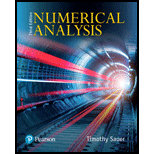
Concept explainers
a)
To find: The MCDT of the given input.
a)
Answer to Problem 1E
Explanation of Solution
Given:
Calculation:
Consider the given data
MCDT stands for Modified discrete cosine transform.
The MCDT of the matrix is
Therefore, the MCDT of given input is
b)
To find: The MCDT of the given input.
b)
Answer to Problem 1E
Explanation of Solution
Given:
Calculation:
Consider the given data
MCDT stands for Modified discrete cosine transform.
The MCDT of the matrix is
Therefore, the MCDT of given input is
c)
To find: The MCDT of the given input
c)
Answer to Problem 1E
Explanation of Solution
Given:
Calculation:
Consider the given data
MCDT stands for Modified discrete cosine transform.
The MCDT of the matrix is
Therefore, the MCDT of given input is
Want to see more full solutions like this?
Chapter 11 Solutions
Numerical Analysis
- Points z1 and z2 are shown on the graph.z1 is at (4 real,6 imaginary), z2 is at (-5 real, 2 imaginary)Part A: Identify the points in standard form and find the distance between them.Part B: Give the complex conjugate of z2 and explain how to find it geometrically.Part C: Find z2 − z1 geometrically and explain your steps.arrow_forward[) Hwk 29 SUBMIT ANSWER Hwk 29 - (MA 244-03) (SP25) || X - Mind Tap Cengage Learning ☑ MA244-03_Syllabus_Spring, 20 × b Answered: ( Homework#8 | ba X + https://www.webassign.net/web/Student/Assignment-Responses/submit?dep=36606608&tags=autosave#question3706218_2 2. [-/2.85 Points] DETAILS MY NOTES LARLINALG8 7.3.003. Prove that the symmetric matrix is diagonalizable. (Assume that a is real.) 0 0 a A = a 0 a 0 0 Find the eigenvalues of A. (Enter your answers as a comma-separated list. Do not list the same eigenvalue multiple times.) λ= Find an invertible matrix P such that P-1AP is diagonal. P = Which of the following statements is true? (Select all that apply.) ☐ A is diagonalizable because it is a square matrix. A is diagonalizable because it has a determinant of 0. A is diagonalizable because it is an anti-diagonal matrix. A is diagonalizable because it has 3 distinct eigenvalues. A is diagonalizable because it has a nonzero determinant. A is diagonalizable because it is a symmetric…arrow_forwardA polar curve is represented by the equation r1 = 7 + 4cos θ.Part A: What type of limaçon is this curve? Justify your answer using the constants in the equation.Part B: Is the curve symmetrical to the polar axis or the line θ = pi/2 Justify your answer algebraically.Part C: What are the two main differences between the graphs of r1 = 7 + 4cos θ and r2 = 4 + 4cos θ?arrow_forward
- A curve, described by x2 + y2 + 8x = 0, has a point A at (−4, 4) on the curve.Part A: What are the polar coordinates of A? Give an exact answer.Part B: What is the polar form of the equation? What type of polar curve is this?Part C: What is the directed distance when Ø = 5pi/6 Give an exact answer.arrow_forwardNew folder 10. Find the area enclosed by the loop of the curve (1- t², t-t³)arrow_forwardSolve questions by Course Name Ordinary Differential Equationsarrow_forward
- 1. Graph and find the corresponding Cartesian equation for: t X== y = t +1 2 te(-∞, ∞) 42,369 I APR 27 F5 3 MacBook Air stv A Aa T 4 DIIarrow_forwardMiddle School GP... Echo home (1) Addition and su... Google Docs Netflix Netflix New folder 9. Find the area enclosed by x = sin²t, y = cost and the y-axis.arrow_forward2. Graph and find the corresponding Cartesian equation for: (4 cos 0,9 sin 0) θ ε [0, 2π) 42,369 I APR 27 3 MacBook Air 2 tv A Aaarrow_forward
- 30 Page< 3. Find the equation of the tangent line for x = 1+12, y = 1-3 at t = 2 42,369 APR A 27 M . tv NA 1 TAGN 2 Aa 7 MacBook Air #8arrow_forwardCan you cut the 12 glass triangles from a sheet of glass that is 4 feet by 8 feet? If so, how can it be done?arrow_forwardCan you cut 12 glass triangles from a sheet of glass that is 4 feet by 8 feet? If so, draw a diagram of how it can be done.arrow_forward
- Algebra & Trigonometry with Analytic GeometryAlgebraISBN:9781133382119Author:SwokowskiPublisher:Cengage
 Trigonometry (MindTap Course List)TrigonometryISBN:9781305652224Author:Charles P. McKeague, Mark D. TurnerPublisher:Cengage Learning
Trigonometry (MindTap Course List)TrigonometryISBN:9781305652224Author:Charles P. McKeague, Mark D. TurnerPublisher:Cengage Learning

